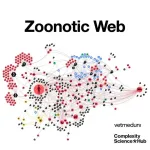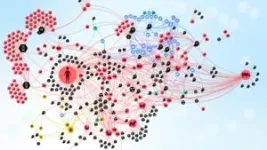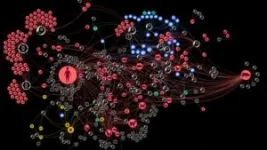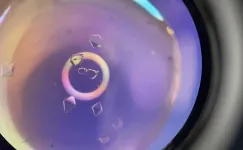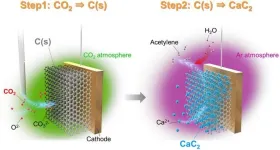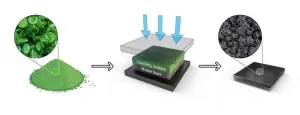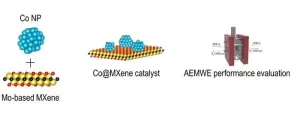(Press-News.org) [Vienna, July 11 2024] — Researchers from the Complexity Science Hub and the University of Veterinary Medicine Vienna have dissected the complex interactions involved in zoonoses, which affect worldwide over two billion people annually. They introduce the concept of a "zoonotic web," a detailed network representation of the relationships between zoonotic agents, their hosts, vectors, food sources, and the environment.
"Zoonotic diseases, which can be transmitted between animals and humans, are a significant public health concern, and our study highlights the importance of a holistic approach to understanding and managing these risks," says epidemiologist and CSH researcher Amélie Desvars-Larrive.
Transmission context
The transmission of zoonoses to humans can occur through direct contact with saliva, blood, urine, or even feces of infected animals. For instance, a bite (for rabies), a scratch (for cat scratch disease), or skin contact (for skin fungi). Indirect transmission can also occur through bites from arthropod vectors -- as with West Nile virus and tick-borne encephalitis – or through contact with contaminated objects, environments, or surfaces.
“For example, the food and water we consume can be potential routes of infection for zoonoses,” adds Desvars-Larrive, also an associate professor at the University of Veterinary Medicine, Vienna (Vetmeduni).
More than host-pathogen interaction
“Zoonotic diseases are often discussed in terms of host-pathogen interactions. Understanding the complex animal-human-environment interface remains a significant challenge,” explains the epidemiologist.
“As co-author Anja Joachim pointed out, simply studying the presence of a parasite in cat faeces, like Toxoplasma, doesn't tell the whole story. Are we looking at the cat-environment, environment-human, or cat-human interface?. The concept of ‘interface’ remained unclear. This motivated us to develop a novel approach to zoonoses and demonstrate it through a case study,” adds Desvars-Larrive.
"We wanted to develop a method that investigates the interfaces where the exchange of circulating zoonotic pathogens takes place. This goes beyond host-pathogen interactions to consider other sources of infection, such as a contaminated environment, for example a sandpit, or contaminated food, often neglected when modeling zoonotic disease dynamics."
Austrian data spanning almost 50 years
The researchers first carried out a systematic literature search on all documented interactions between zoonotic sources and pathogens in Austria between 1975 and 2022. From this, they created the “zoonotic web.” The results of the analysis were finally prepared in a dashboard by CSH data visualization expert Liuhuaying Yang.
The team identified six distinct communities of zoonotic agent sharing in Austria, influenced by highly connected infectious agents, proximity to humans, and human activities. The community including humans, the oldest domesticated species – including dogs, cats, sheeps, cattle, and pigs – and species that have adapted to live together with humans – for instance, house mouse – shares the most zoonotic agents, according to the study.
The findings also highlight the important role some animals, such as the wild boar, dog, domestic cat, yellow-necked field mouse, or the raccoon dog, and arthropods, especially ticks, play in “bridging” host communities. "Knowing which actors in the network are more influential than others can be very helpful in zoonotic disease surveillance programs, for example, as they could serve as sentinels for monitoring zoonotic agent circulation," says Desvars-Larrive.
A quantitative approach to One Health
A major challenge for the One Health community is quantifying the interactions and risks at the human-animal-environment interface. The One Health approach recognizes the health of humans, domestic and wild animals, plants, and the wider environment are closely linked and interdependent.
Using a quantitative approach based on the One Health concept and specific structures in the network, the research confirms that, in Austria, zoonotic spillover is most likely to occur at human-cattle and human-food interfaces. “Eating contaminated food poses a major risk of human zoonotic infection, with Listeria, Salmonella, and Escherichia being the most frequently reported agents in our study,” says Desvars-Larrive.
Public awareness
"With our interactive map, we also hope to arouse curiosity and educate," adds the epidemiologist. "We all come into contact with pathogens, but only a few cause illness, so we shouldn't worry too much. But it is still important to develop some awareness – for example, how to prevent cross-contamination by cleaning your knife between foods.”
"Or if you have been bitten by a tick, you should be vigilant over the next few days or even weeks, as ticks transmit a whole range of diseases to humans and animals, which are often difficult to diagnose as the symptoms may not appear until weeks later," says Desvars-Larrive.
About the study and dashboard
The study “A One Health framework for exploring zoonotic interactions: a case study" by A. Desvars-Larrive, A. E. Vogl, G. A. Puspitarani, L. Yang, A. Joachim and A. Käsbohrer is available in Nature Communications.
You can access the dashboard "Zoonotic Web" at https://vis.csh.ac.at/zoonotic-web/
About CSH
The Complexity Science Hub (CSH) is Europe’s research center for the study of complex systems. We derive meaning from data from a range of disciplines – economics, medicine, ecology, and the social sciences – as a basis for actionable solutions for a better world. Established in 2015, we have grown to over 70 researchers, driven by the increasing demand to gain a genuine understanding of the networks that underlie society, from healthcare to supply chains. Through our complexity science approaches linking physics, mathematics, and computational modeling with data and network science, we develop the capacity to address today’s and tomorrow’s challenges.
END
Study unveils complexity of zoonotic transmission chains
Dive into the interactive visualization to explore the intricate interactions of zoonoses—diseases that jump between animals and humans—in one country
2024-07-15
ELSE PRESS RELEASES FROM THIS DATE:
30-year risk of cardiovascular disease may help inform blood pressure treatment decisions
2024-07-15
Research Highlights:
A comparison of two tools for calculating cardiovascular disease risk found that if only the current 10-year risk thresholds are applied, fewer adults may be recommended for blood pressure-lowering medication. The tools, The American Heart Association’s new PREVENTTM tool and the Pooled Cohort Equations, were applied to a cross-sectional sample of adults from NHANES datasets with stage 1 hypertension who did not report having CVD.
PREVENT can additionally be used to calculate an individual’s 30-year risk ...
Off-the-shelf wearable trackers provide clinically-useful information for patients with heart disease
2024-07-15
Monitoring of heart rate and physical activity using consumer wearable devices was found to have clinical value for comparing the response to two treatments for atrial fibrillation and heart failure.
The study published in Nature Medicine examined if a commercially-available fitness tracker and smartphone could continuously monitor the response to medications, and provide clinical information similar to in-person hospital assessment.
The wearable devices, consisting of a wrist band and connected smartphone, collected a vast amount of data on the response to two different medications prescribed ...
Visualizing addiction: How new research could change the way we fight the opioid epidemic
2024-07-15
New research from a Max Planck Florida Institute for Neuroscience researcher could transform how we understand the way opioids affect the brain. Despite significant discussion surrounding the ongoing opioid crisis, current understanding of how opioids function in the brain is quite limited. This is primarily due to challenges in observing and measuring opioid effects in the brain in real-time. However, a recent technological breakthrough, led by Dr. Lin Tian and her research team and collaborators, recently published in Nature Neuroscience, has overcome these limitations and is set to transform how scientists study opioid signaling ...
Caught in the actinium
2024-07-15
The element actinium was first discovered at the turn of the 20th century, but even now, nearly 125 years later, researchers still don’t have a good grasp on the metal’s chemistry. That’s because actinium is only available in extremely small amounts and working with the radioactive material requires special facilities. But to improve emerging cancer treatments using actinium, researchers will need to better understand how the element binds with other molecules.
In a new study led by the Department of Energy’s Lawrence Berkeley National Laboratory (Berkeley Lab), ...
Out-of-pocket medical costs are substantial and rising for privately insured men with abnormal prostate cancer screening results who require further diagnostic testing
2024-07-15
Prostate-specific antigen (PSA) screening aims to identify men who may harbor potentially lethal prostate cancer, and those with high PSA results often require more extensive (and expensive) diagnostic testing to establish a diagnosis. New research reveals that the out-of-pocket costs for such additional tests are substantial, common, and rising. The findings are published by Wiley online in CANCER, a peer-reviewed journal of the American Cancer Society.
Abnormal screening tests (i.e., elevated PSA) warrant ...
A new method for sustainable synthesis of acetylene from carbon dioxide
2024-07-15
Since its discovery, in 1836, acetylene has emerged as an essential chemical compound in industry, widely used as a chemical building block and fuel. It has applications in the raw material for resins, such as vinyl chloride, welding gas, and illumination. Recent developments aimed at reducing the dependence on petroleum feedstocks have shown that acetylene is a promising platform molecule for producing various base chemicals. Additionally, polyacetylene, a crucial semiconducting material, is made from acetylene. Currently, acetylene is mainly produced through two methods: ...
Localization of anion exchange membrane water electrolysis is a step forward!
2024-07-15
A research team led by Dr. Sung Mook Choi of the Korea Institute of Materials Science, a government-funded research institute under the Ministry of Science and ICT, has developed a one-step electrode fabrication process for the first time in South Korea. This process produces electrodes, a key component of anion exchange membrane water electrolysis, directly from raw materials to a mass-producible level. The team successfully applied this process to a commercial-scale stack of anion exchange membrane water ...
Atomically controlled MXenes enable cost-effective green hydrogen production
2024-07-15
137 countries around the world have signed a "net-zero" climate change agreement to end fossil fuel use and achieve zero carbon emissions by 2050. Hydrogen is being touted as the next green energy source because it emits only water and oxygen when utilized as an energy source. Hydrogen production methods are divided into gray hydrogen, blue hydrogen, and green hydrogen depending on the energy source and carbon emissions. Among them, green hydrogen production method is the most eco-friendly method that produces hydrogen without carbon emissions by electrolyzing water using green energy.
A research team led by Dr. ...
Survey finds most americans believe pain and urinary leakage is normal for women after having children
2024-07-15
Orlando, Fla - A new national survey by the Orlando Health Advanced Rehabilitation Institute finds most Americans believe it’s normal for women to experience pain, pressure and incontinence after having children. But experts say these are actually signs of pelvic floor issues, and while they are extremely common, affecting about a third of women, they are not normal.
“When we say it's not normal, what we mean is it's not something you should have to live with. It's something ...
Opioid prescribing to reduce overdoses, misuse
2024-07-15
New research aims to help reduce the quantity of unused prescription opioids after emergency department visits and lessen the risk of opioid misuse and overdose. The study is published in CMAJ (Canadian Medical Association Journal) https://www.cmaj.ca/lookup/doi/10.1503/cmaj.231640.
VIEW EMBARGOED ARTICLE
Overprescribing is linked to opioid misuse and overdose, with household supplies of opioids associated with an increased risk of overdose, as many people do not dispose of unused medications safely. In Canada, ...
LAST 30 PRESS RELEASES:
Why nail-biting, procrastination and other self-sabotaging behaviors are rooted in survival instincts
Regional variations in mechanical properties of porcine leptomeninges
Artificial empathy in therapy and healthcare: advancements in interpersonal interaction technologies
Why some brains switch gears more efficiently than others
UVA’s Jundong Li wins ICDM’S 2025 Tao Li Award for data mining, machine learning
UVA’s low-power, high-performance computer power player Mircea Stan earns National Academy of Inventors fellowship
Not playing by the rules: USU researcher explores filamentous algae dynamics in rivers
Do our body clocks influence our risk of dementia?
Anthropologists offer new evidence of bipedalism in long-debated fossil discovery
Safer receipt paper from wood
Dosage-sensitive genes suggest no whole-genome duplications in ancestral angiosperm
First ancient human herpesvirus genomes document their deep history with humans
Why Some Bacteria Survive Antibiotics and How to Stop Them - New study reveals that bacteria can survive antibiotic treatment through two fundamentally different “shutdown modes”
UCLA study links scar healing to dangerous placenta condition
CHANGE-seq-BE finds off-target changes in the genome from base editors
The Journal of Nuclear Medicine Ahead-of-Print Tip Sheet: January 2, 2026
Delayed or absent first dose of measles, mumps, and rubella vaccination
Trends in US preterm birth rates by household income and race and ethnicity
Study identifies potential biomarker linked to progression and brain inflammation in multiple sclerosis
Many mothers in Norway do not show up for postnatal check-ups
Researchers want to find out why quick clay is so unstable
Superradiant spins show teamwork at the quantum scale
Cleveland Clinic Research links tumor bacteria to immunotherapy resistance in head and neck cancer
First Editorial of 2026: Resisting AI slop
Joint ground- and space-based observations reveal Saturn-mass rogue planet
Inheritable genetic variant offers protection against blood cancer risk and progression
Pigs settled Pacific islands alongside early human voyagers
A Coral reef’s daily pulse reshapes microbes in surrounding waters
EAST Tokamak experiments exceed plasma density limit, offering new approach to fusion ignition
Groundbreaking discovery reveals Africa’s oldest cremation pyre and complex ritual practices
[Press-News.org] Study unveils complexity of zoonotic transmission chainsDive into the interactive visualization to explore the intricate interactions of zoonoses—diseases that jump between animals and humans—in one country
